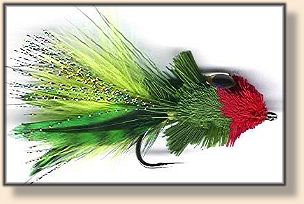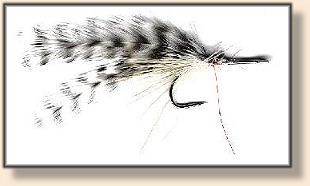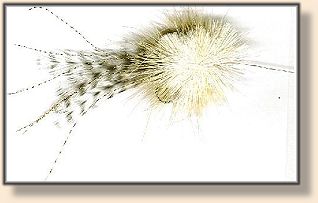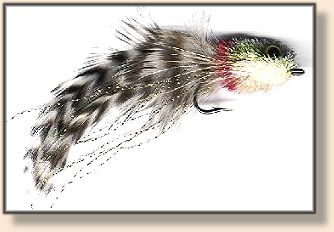Mullet Fly
By Captain Doug Sinclair
I think it was Dick Catherwood who recorded a Sand Perch fly
in Lefty Kreh's book on Saltwater Flies. I'm not sure who is
credited with the original design. It's been sliced and diced a
number of different ways. I've experimented with this fly for
years. Just when you think it works best one way, you make
a slight change and the new one works better. All this past
winter I made a mullet fly that has a green body and red head.

Snook could not resist this fly. It didn't matter if they were big
snook or small snook. They just went crazy after this fly. I can't
tell you the reason - but color has to be a factor. We tried combinations
of green/white, yellow/green, yellow/red, white/red, tan/red, tan/blue,
and green/red. The green/red worked 100 percent of the time and
not even a bump on the others. The flies were tied exactly the same way.
Go figure. What does a snook see? I'm a fish and I'm looking up seeing
a silhouette on the surface. Can a snook see green and a red head? I
can't figure this out and it probably doesn't matter. What matters is that
snook seem to like this color now. Last year it was a tan mullet fly.
We were so positive that the Tomoka Mullet (named by Ken Bay)
was the perfect color combination that I made up dozens of them.
Now they work great in Spruce Creek or Ponce Inlet for Jacks and
Bluefish, but the snook won't even look at them. Even JB Cook,
a guide out of Satellite Beach wrote me this note:
"I wanted to say thanks again for the flies you gave me. I had to make
Rodney (Smith) give them up long enough to catch 8 snook to 12 lbs.
along with some dinkish trout and a bluefish last Saturday morning on
a charter! The finger mullet was the ticket. It was the morning after
our first REAL rain. The creeks were full to flow and flush out baitfish
that would not normally be on the move. This is one of my favorite times
of the year, in my beloved snook spots. Needless to say my charter from
California was stoked with his catch. The 12-pounder hit on his first
cast!!! This was one of my better producing charters. Thought you
might like to know that the finger mullet fly is on his last leg!!! Poor thing...."
But not this year. The old tan mullet fly has been replaced by the Little
Redhead. The tying directions are exactly the same though. This is a
classic fly and easy to tie. Here is how I tie the green-redheaded mullet.
Recipe Mullet Fly
Hook: Mustad #34007 (1/0 or 2/0).
Head: Deer Hair (Green),
I use 3-4 clumps of Red at the end to the hook eye.
Thread: Size G Gray thread, except at the end I
whip finish with red G thread.
Tail: Tan or Green Saddle Hackle (1 ½ inches).
Tie in six strands of pearl, ice or teal Krystal flash..
Body: Deer Hair (Green). I stack the hair more
tightly than shown in the picture. The looser the stack, the more
air/water mixture in the retrieve.
Tying Steps:
1. Start by tying off a small section of thread in front of the bend and then
to the curve of the shank. I tie in a small clump of tan marabou or Bucktail.
Then tie in four pieces of saddle hackle (two each side, curve out). Next
tie six strands of Krystal flash.

2. Take a clump (pencil thickness) of deer hair and hold it parallel and
on top of the hook shank. Now make two loose turns of the thread,
pinching it into your thumb so that you can pull down with the bobbin
to tighten the loop. By doing this and applying even pressure you can
spin/stack the deer hair firmly and quickly. Lay in two more clumps,
making two thread wraps in front. Using your thumb and index finger
push the clumps together snuggly. Continue stacking and pushing the
clumps together until you reach the hook eye. Whip finish the end
and put a drop of head cement on the thread.
3. Now you are looking at the most ugly fly you've ever tied. The
final step is the haircut. First, trim the bottom flat from the hook eye
to inside the bend below the hook.

4. Use a razor blade or scissors. Be careful. Shave a flat spot about
3/8 to ½ inch wide (this is the part that moves across the top of the water).
Next trim the hair from the hook eye back. Cut away small sections of
hair, trimming to make the uniform shape of the fly. Sometimes I'll cut
back only to within 1/8 inch of the hackles so that the fly will have a section
of standing hair. You can see this in Ol'Yeller or Pigfish fly below.

|



